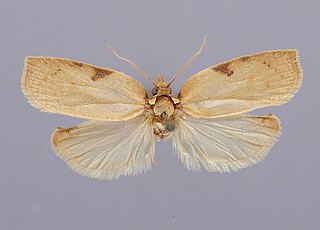
Hyles lineata, also known as the white-lined sphinx, is a moth of the family Sphingidae. They are sometimes known as a "hummingbird moth" because of their bird-like size and flight patterns.

Keiferia is a genus of moths in the family Gelechiidae.

Peridroma saucia, the pearly underwing or variegated cutworm, is a moth of the family Noctuidae. The species was first described by Jacob Hübner in 1808. It is found in North and South America, Europe, Asia and Africa. The variegated cutworm feeds on many plants, especially common fruits and vegetables. The moth undergoes two to four generations per year. The development of the moth slows in colder temperatures, indicative of its migratory nature. All stages of the life cycle have a developmental threshold for temperature. The moth is known to migrate to the northern regions during warmer months, returning to the southern regions when the climate becomes colder.

Agrotis malefida, the rascal dart or palesided cutworm, is a moth in the family Noctuidae. Its range extends from North Carolina and Kentucky south to Florida, west to Arizona, and north to southern Kansas. It is also found in the Neotropics, from Mexico to Argentina and Chile.
Stigmella inconspicuella is a moth of the family Nepticulidae. It is found in California, United States.

Amyna axis, the oriental eight-spot, is a moth of the family Noctuidae. The species was first described by Achille Guenée in 1852.

Amorbia emigratella, the Mexican leaf-roller, is a moth of the family Tortricidae. Although it was described from Hawaii, it is known to be a native of the southern United States, Mexico and Central America. It was first described by August Busck in 1910.

Clepsis peritana, the garden tortrix or strawberry garden tortrix, is a species of moth of the family Tortricidae. It is found in Spain, Cuba, as well as North America, where it has been recorded from southern Canada throughout the United States.
Rhectocraspeda periusalis, the eggplant webworm moth, is a moth in the family Crambidae. It was described by Francis Walker in 1859. It is found in the West Indies and from the United States, where it has been recorded from Florida, North Carolina, Ohio, Oklahoma, South Carolina and Tennessee, south through Mexico and Central America to South America, including Ecuador, Brazil, Guyana, Trinidad and Tobago and Suriname.

Frechinia helianthiales is a moth in the family Crambidae. It was described by Mary Murtfeldt in 1897. It is found in North America, where it has been recorded from Arizona, Illinois, Manitoba, Missouri and Oklahoma, south to Mexico.
Neoleucinodes prophetica, the potato tree borer, is a moth in the family Crambidae. It was described by Harrison Gray Dyar Jr. in 1914. It is found in Puerto Rico, Cuba, Jamaica, the Dominican Republic, Guatemala, Costa Rica, Panama, Honduras, Peru, Venezuela, Colombia, Trinidad and Tobago and Brazil. It is also present in southern Florida.

Leucinodes cordalis, the poroporo fruit borer or eggfruit caterpillar, is a species of moth in the family Crambidae. It is found in New Zealand, Australia and Indonesia (Sulawesi). In Australia, it has been reported from Norfolk Island, the Northern Territory, Queensland, New South Wales, the Australian Capital Territory, Victoria, Tasmania and South Australia. The species was first described by Henry Doubleday in 1843.
Helcystogramma chambersella is a moth in the family Gelechiidae. It was described by Mary Murtfeldt in 1874. It is found in North America, where it has been recorded from Pennsylvania, Illinois, Ohio, South Carolina, Tennessee, Louisiana, Mississippi, Florida, Oklahoma, Missouri, Texas, Arizona and California.
Keiferia altisolani is a moth in the family Gelechiidae. It was described by Kieffer in 1937. It is found in North America, where it has been recorded from California.
Keiferia elmorei is a moth in the family Gelechiidae. It was described by Keifer in 1936. It is found in North America, where it has been recorded from California.
Keiferia georgei is a moth in the family Gelechiidae. It was described by Ronald W. Hodges in 1985. It is found in North America, where it has been recorded from Illinois.
Keiferia glochinella, the eggplant leafminer moth, is a moth in the family Gelechiidae. It was described by Zeller in 1873. It is found in the United States, where it has been recorded from Texas, New Mexico and California. Records outside the western United States are based on misidentifications.
Keiferia gudmannella is a moth in the family Gelechiidae. It was described by Thomas de Grey in 1897. It is found in the West Indies, where it has been recorded from Cuba, Hispaniola and Puerto Rico.

Symmetrischema striatella is a moth in the family Gelechiidae. It was described by Mary Murtfeldt in 1900. It is found in North America, where it has been recorded Alabama, Arkansas, California, Florida, Illinois, Louisiana, Maine, Maryland, Mississippi, Missouri, New Jersey, Oklahoma, South Carolina, Tennessee and Texas. This species has also been accidentally introduced to New Zealand.
Trichobaris trinotata, commonly known as the potato stalk borer, is a species of weevil in the family Curculionidae. It is found in North America where it is a pest of potato plants, the larvae tunnelling inside their stems.









